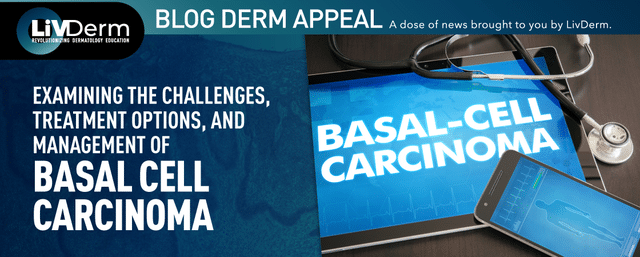The Skin Cancer Foundation reports that the diagnosis and treatment of nonmelanoma skin cancers in the U.S. increased by 77% between 1994 and 2014. Of the types diagnosed, basal cell carcinoma (BCC) is the most common, with approximately 3.6 million cases seen each year.
BCC Risk Factors
Experts attribute a large number of BCC cases to misinformation and a general lack of understanding concerning the risks of sun exposure and tanning booths. In fact, 90% of nonmelanoma skin cancers are associated with exposure to UV radiation from the sun. To highlight this point, a recent survey evaluating the sun safety habits of millennials and Gen Xers found that only 19% of respondents stated they used sunscreen year-round, with 78% stating that they go outside on sunny days without sunscreen. The survey also revealed that 35% of the respondents have used tanning beds, with 22% of millennials falsely believing that tanning beds are safer than outdoor tanning, compared with 11% of Gen Xers who believe the same. According to research, indoor tanning facilities can in fact emit UV radiation in amounts of 10 to 15 times higher than the sun at its peak intensity.
Other risk factors for BCC to consider are an individual’s physical traits or demographics, such as their skin color or where they live. Research has also pointed to a number of genetic disorders, such as albinism, that can increase a person’s risk for BCC, as can organ transplants.
The Importance of Early Detection
Most cases of BCC are curable if caught and treated early. There are, however, a number of points that need to be taken into consideration when looking at detection and screening. For instance, many patients opt to ignore warning signs and only see a dermatologist as a last resort. Many still do not see the importance of regular screening. In the survey mentioned above, only 25% of millennials and Gen Xers stated that they were very likely to get skin cancer screening if they did not see any notable changes on their skin. Such decisions may also be largely driven by the fact that many insurance companies will not cover cancer screening as part of their plan.
A further consideration concerns the shortage of dermatologists to cater to an ever-growing patient base. A study published in May 2023 revealed that out of 712 populated zip codes with dermatologists, 510 had less than four dermatologists per 100,000 people, revealing a significant maldistribution of dermatologists in the U.S.
As a means to help take the pressure off the lack of dermatologists, Laura K. Ferris, MD, PhD, helps to lead a skin cancer screening initiative in Pittsburgh, Pennsylvania. Dr. Ferris is an associate professor in the Department of Dermatology and Clinical and Translational Science Institute at the University of Pittsburgh. The program teaches primary care physicians (PCP) about skin cancer and encourages them to provide screenings as part of their routine checkups. Not only has this initiative helped take the pressure off, but according to Dr. Ferris, the findings from this initiative suggest that “PCP screening is an effective way to improve early detection of melanoma, which could potentially save lives.”
Related reading: Cutaneous Oncology in Primary Care
Treatment Options for BCC
During a recent Frontline Forum hosted by Dermatology Times, experts Dr. Ferris, Aaron S. Farberg, MD, John M. Strasswimmer, MD, PhD, Andrew H. Weinstein, MD, and Neal Bhatia, MD, weighed in on the various elements surrounding the treatment and management of BCC.
One of the topics discussed was the choice of treatments and how to go about finding the right treatment path. Although the gold standard treatment for BCC is typically surgery, the panel of experts agreed that whatever treatment plan is chosen must be in alignment with and personalized to the patient. A number of factors must be considered when opting for the right type of treatment, including the age of the patient, the location, type, and size of the lesion, its pathology, as well as the risk factors associated with each treatment type. All of these will greatly affect whether to go down the route of Mohs surgery, electrodesiccation and curettage, radiation therapy, cryosurgery, topical options, or other form of treatment.
Hedgehog inhibitor (HHI) therapy is another effective treatment option for BCC, but the difficulty with HHI lies in the management of its side effects. Some of these, such as muscle cramps, dysgeusia (loss of taste), and hair loss, may be too much for some patients to endure, leading to the discontinuation of therapy. During his presentation at the 2023 South Beach Symposium in Miami Beach, Dr. Farberg shared some tips and tricks to help patients overcome some of these side effects. This includes the use of L-Carnitine for muscle cramps and the berry from a West African plant (synsepalum dulcificum), known as the ‘miracle fruit’ for dysgeusia.
Another nonsurgical option is radiation therapy, which, according to Dr. Strasswimmer, is seeing a resurgence as there are now more devices available. He does mention that the challenge surrounding radiation therapy is that it requires many office visits and long-term side effects can cause more skin cancer and scarring.
Cemiplimab (Libtayo), a PD-1 immune checkpoint inhibitor, is another option that dermatologists are now making more use of for the treatment of BCC. This can be used in patients for whom HHI therapy has not worked or may not be appropriate. According to Dr. Weinstein, checkpoint inhibitors like cemiplimab come into play for many patients in which BCC has become a complex disease. He states that cemiplimab specifically has known efficacy for complicated BCC.
The Role of Multidisciplinary Care for BCC Patients
A multidisciplinary care approach is considered hugely important for patients with BCC, especially those with more challenging cases. This is something that a lot of the time tends to be overlooked. However, having a team of experts including dermatologists, medical and surgical oncologists, radiation oncologists, Mohs surgeons, nurse practitioners, pharmacists, and pathologists, can prove a great tool in the treatment for the patient moving forward. Dr. Farberg believes that “it is our job as dermatologists to be a multidisciplinary advocate.”
“When we first got access to immune checkpoint inhibitor therapy for skin cancer—for nonmelanoma skin cancers, [BCC], and advanced squamous cell carcinomas—my initial conversation with some of the oncologists [was] really frustrating. They didn’t know why they should see a patient with [BCC] or squamous cell [carcinoma] because in the past, they really didn’t have anything to offer them.”
Dr. Bhatia
Despite these challenges, a team of experts who understand the needs of the patient, what they are dealing with, and how each specialist can do their part in aiding in treatment and recovery is essential.
“Everyone involved in surgical dermatology should have a support group made up of medical oncologists, likely an ENT surgeon, plastic surgical specialists who are able to help you. The time to have support from colleagues in other disciplines is not when you need it. The time to develop that support is before you need it and to have a cooperative relationship; one that is mutually beneficial and most importantly, is beneficial to your patient.”
Dr. Weinstein
Looking Ahead
One important thing to consider moving forward with treating BCC is to make use of what is available and to not be afraid to try some of the newer and more advanced treatments.
“It's been great to have this variety of different therapeutic options. Being able to modify the disease with these medications has been a huge advantage for what otherwise, 10 or 15 years ago, we didn’t really have a whole lot of options for these patients. We need to be knowledgeable of these medications and this is an opportunity for us to be an advocate.”
Dr. Farberg
Key Takeaway
As with any disease, finding the right treatment plan for BCC can come with a variety of challenges. As the experts reveal, it is essential to know your patient and what they are presented with. An awareness of their preferences, of what they can or may be unwilling to endure, must all be taken into consideration. Additionally, some cases of BCC may be complex and therefore it may be beneficial to employ a team of experts who can provide optimal care for a more positive treatment outcome.
Furthermore, remaining abreast of the latest treatment options and therapies is key to being able to provide your patients with the best care. LiVDerm’s Cutaneous Oncology Digital Education Hub is a great way to stay up-to-date on the latest education. It is regularly updated with sessions from past events.
- https://www.skincancer.org
- https://www.businesswire.com/news/home/20230405005007/en/New-Survey-Finds-Millennials-and-Gen-Xers-Not-Following-Safe-Sun-Habits-Increasing-Risk-of-Nonmelanoma-Skin-Cancer
- https://cdn.sanity.io/files/0vv8moc6/dermatologytimes/e36f783f08e89ecf9540130cbcd90094b46c051d.pdf/DT0523supp-Regen_ezine.pdf
- https://www.upmc.com/media/news/l-ferris-asco
- https://jofskin.org/index.php/skin/article/view/1709
- https://www.dermatologytimes.com/view/expert-perspectives-on-the-role-of-interdisciplinary-care-in-bcc
- https://www.dermatologytimes.com/view/basal-cell-carcinoma-management-challenges
- https://www.dermatologytimes.com/view/clinical-utilization-of-cemiplimab-and-future-directions




















